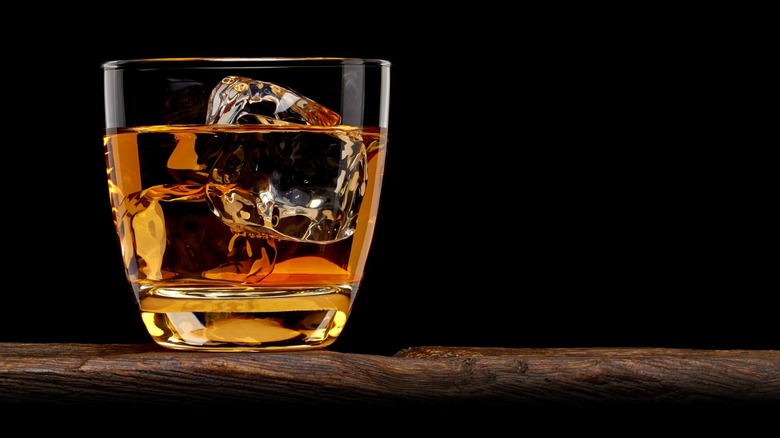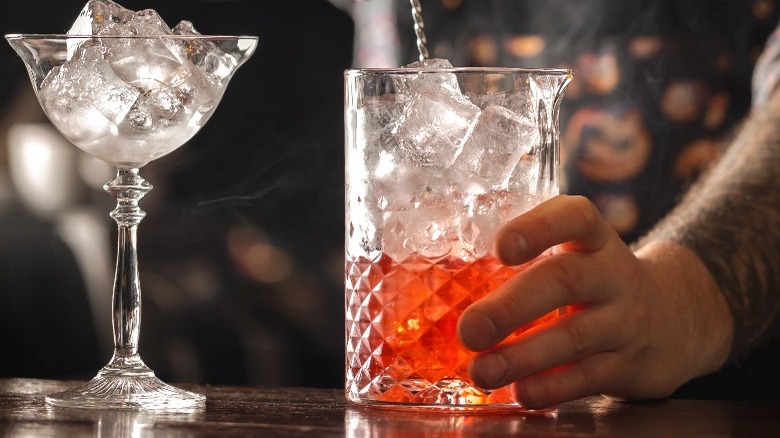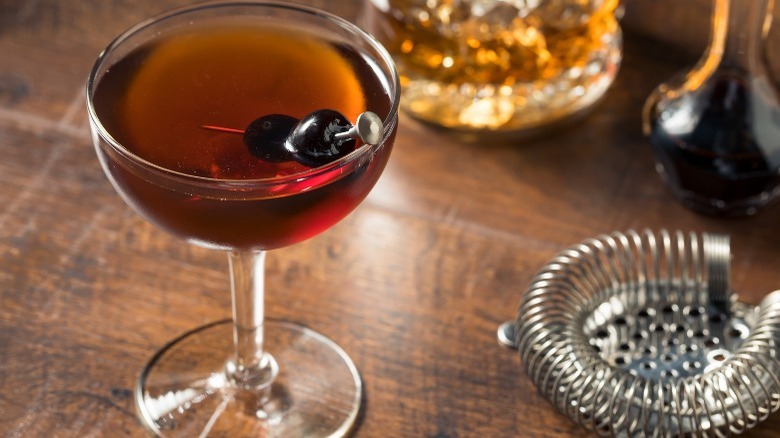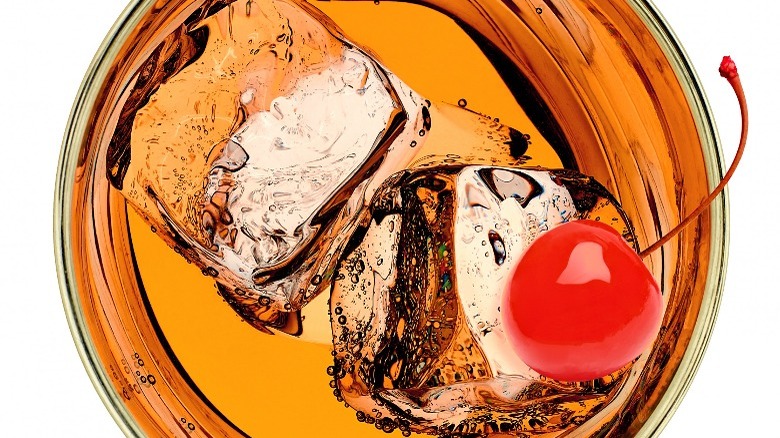Why You May Want To Order Your Next Manhattan On The Rocks
We may receive a commission on purchases made from links.
There's something streamlined and sexy about classic cocktails. Just like classic cars, they're all about style and craftsmanship, elegant in their simplicity, built to last, and brimming with nostalgia. We're talking about glasses filled with strong liquor, balanced by pungent bitters, sharp citrus, a spicy kick, or sweet vermouth — drinks like the old fashioned, martini, gimlet, Negroni, Bloody Mary, and the aptly named Manhattan (all of which sit squarely on the National Bartending School's list of 18 Cocktails Every Bartender Should Know). And while plenty of mixologists modernize the oldies, adding a little Tszuj (in the words of Queer Eye guy Carson Kressly) with their cinnamon-infused smoke and splashes of mezcal, the truth is the classics still serve, just as they are — or rather, were.
But preferring the classics doesn't mean there isn't room for variation. Something as simple as swapping gin for vodka in the martini creates the now timeless vodka martini. And while too many argue over shaking or stirring the aforementioned drink, there are also those who believe that adding ice to a rock glass and serving your martini or your Manhattan on the rocks is blasphemy — it just isn't so. While cocktail artisans might wince when you order it, adding ice to your Manhattan takes it from the hallowed mahogany halls of the elite's private clubs and hands it straight to the common man. In fact, serving these legendary cocktails over ice has a history almost as classic as the drinks themselves.
The Manhattan Club
The most popular Manhattan origin story starts at its assumed namesake, the Manhattan Club. According to cocktail and food tour group Revelry Tours, the Manhattan Club (started in 1865) was the newest of eight social clubs in New York, most of which were filled with New York's elite (it was rumored that John D. Rockefeller couldn't even get into the Knickerbocker). But the Manhattan Club was decidedly more political; as a 1915 New York Times article details, it was started by a group of "representative Democrats who might fitly be associated together," including its first President, John Van Buren (the son of former U.S. president, Martin Van Buren). Moving its headquarters a couple of times before settling in at the Jerome Mansion in 1899, the Manhattan Club saw governors, senators, mayors, and even U.S. President, Grover Cleveland join its membership.
"More than an exhibition of the social elite, the Manhattan Club's legacy is a highlight reel of New York City and State politics," says Revelry Tours, who credits the Manhattan Club as the birthplace of this eponymous cocktail. It was supposedly whipped up by Dr. Iain Marshall at the behest of Winston Churchill's mother, Jennie Jerome Churchill, for a political soiree at the club in November of 1874. According to Difford's Guide, this legend was later declared cocktail mythology by historian David Wondrich in his book, "Imbibe!" due to timeline inconsistencies that put Lady Randolph Churchill in England giving birth to Winston at the time.
The Manhattan's roots
Though cocktail lore had credited Lady Churchhill's doctor, the 1923 book, "Valentine's Manual of Old New York," tells a different tale claiming, "The Manhattan cocktail was invented by a man named Black, who kept a place ten doors below Houston Street on Broadway in the sixties [1860s] . . . ." New Orleans-based culinary and cocktail historian, Elizabeth Pearce notes there's another story, naming Col. Joe Walker, as the cocktail's inventor. Walker ran a notable New Orleans saloon but was rumored to have invented the Manhattan on a trip to New York, though Pearce feels "it's unlikely." In an interview with Sazerac House, Pearce explains that most of the social clubs in New York were serving something similar — a mixture of whiskey, vermouth, and bitters. "The drink was named after the different clubs like the Turf Club cocktail, Jockey Club cocktail and, ultimately, the Manhattan Club cocktail," she says.
Whatever the true origin, it happened in New York. The first written record of this classic libation appears in an article from the Sunday Morning Herald in September 1882. Its first detailed recipe(s) were printed just two years later in O.H. Byron's book, "The Modern Bartenders' Guide." The first recipe featured gum syrup — the second, Curacoa. Chilled Magazine reports that the 1891 book, "The Flowing Bowl," by William Schmidt, calls for both gum and absinthe, though the main ingredients for all three remain the same as the classic Manhattans we enjoy today.
But why order your next Manhattan on the rocks?
Cocktail historian and New York Times contributor Robert Simonson reports in Punch, "Most craft cocktail bars would sooner serve Zima than a Manhattan on the rocks. But outside the most urbane metropolitan areas, the order is fairly common." Even so, Simonson, author of the recently released "Modern Classic Cocktails," notes New York institution, The Campbell, is an outlier in NYC, serving their signature Manhattan on the rocks.
Though there are sticklers like Esquire Magazine that insist the only true Manhattans are those served up, on the rocks became not only an acceptable option but a downright popular one in the 1950s and 60s, "By 1959, you could order a Manhattan on ice aboard Capital Airlines," Simonson says, noting, "the Martini/Manhattan on the rocks is a generational thing," a vestige of times past for those who came of age in a post-World War II time.
So, why should you order your Manhattan on-the-rocks? Simonson says there are various reasons, including keeping your drink cool in the summer heat. It's also a great way to dilute the cocktail for a slower rate of intoxication during the holiday season, work parties, or any time you want to drink, but not to excess. And it makes any time Manhattan time — allowing you to quickly assemble the cocktail at home, " . . . no Martini shakers or pitchers to deal with, no bar spoons or strainers to clean. It's a one-glass operation," says Simonson.



